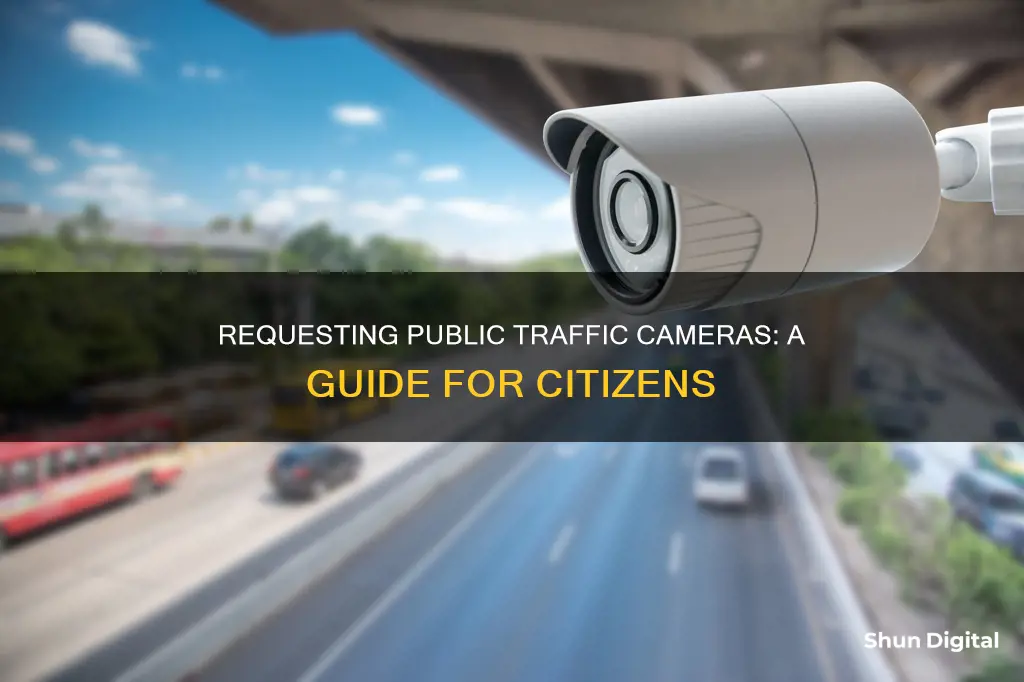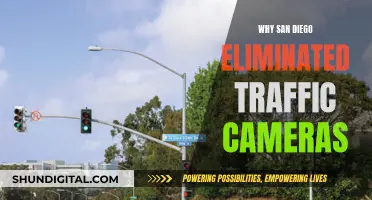
Traffic camera footage can be crucial evidence for determining liability in car accidents and other road incidents. It can provide a neutral, definitive view of what happened and help establish important details such as traffic violations or which driver was at fault. However, obtaining this footage can be complex and frustrating, and the process may vary depending on the type of camera and the agency operating it. This guide will outline the steps to request public traffic camera footage and address some key considerations to keep in mind.
| Characteristics | Values |
|---|---|
| Purpose | Monitoring and managing traffic flow, enhancing safety, aiding law enforcement, providing evidence for insurance, legal or financial claims |
| Types of Cameras | Fixed, mobile, or specialised for specific purposes such as red light enforcement or speed monitoring |
| Camera Locations | Highways, intersections, urban areas, school zones, construction zones, public transportation hubs |
| Accessing Footage | Online platforms, government websites, traffic monitoring apps, navigation apps, dedicated traffic camera apps, traffic camera networks |
| Requesting Footage | Contact relevant government agencies, submit Freedom of Information Act (FOIA) requests, contact private businesses or individuals |
| Timing | Request footage promptly, some agencies retain footage for as little as 14 days |
What You'll Learn

Identify the location of the traffic camera
To request public traffic camera footage, the first step is to identify the location of the traffic camera. This can be done by reviewing the police report or by contacting the local police department or department of transportation.
In some places, there are public databases and maps that allow you to search for and find the location of traffic cameras. For example, in South Australia, you can find camera locations on the SAPOL website or by downloading the SAPOL app. Similarly, in Western Australia, the Western Australia Police Force publishes mobile speed camera locations online weekly, in newspapers, and on the radio.
In the US, there are over 4,100 traffic cameras installed across the country. While some cities may be more transparent about disclosing the locations of their cameras, others may be more secretive, like New York. In such cases, you may rely on reports from people on the ground or use interactive maps that show the locations of traffic cameras, such as the one created by Vox.
Protect Your Privacy: Hack Your Computer Camera
You may want to see also

Determine the camera's jurisdiction
Once you've identified the location of a traffic camera, you need to determine its jurisdiction. This is because the agency that operates the camera will determine who to contact to obtain any video footage.
Traffic cameras may be operated by the local police department, department of transportation, or a private company. Some cameras are owned by the state, city, or county and operated by the Department of Transportation (DOT) or police.
If you're unsure about who operates a particular traffic camera, you can try contacting the local police and the Department of Transportation first. You can also try visiting the local city offices or police station in person and asking the clerk or office for a freedom of information act request form.
It's important to act quickly when requesting traffic camera footage, as the length of time that these cameras keep footage varies. Most traffic camera systems will generally record and store footage from a few days to several weeks, but some systems may store footage for longer periods, up to several months or even years.
Camera Battery Leak: What You Need to Know
You may want to see also

Contact the relevant agency
Once you have identified the agency responsible for the traffic camera footage, the next step is to reach out to their representatives. This may be the local police department, the Department of Transportation, or a private firm. All of these agencies will have contact information available.
Depending on the policies of the jurisdiction's government agency responsible for storing the traffic camera footage, you can typically make a request via phone, email, or a specific website. Some agencies may require you to download a form, fill it out, and then email it back as an attachment or upload it to their website. You can contact these agencies directly or have a proxy, such as a lawyer, contact them on your behalf.
It is worth noting that these requests are often more successful when made by a personal injury lawyer as they have experience in the process and can help you obtain a subpoena if one is required. A lawyer will also be able to help you build your case and ensure you receive the maximum compensation you may be entitled to.
If you choose to make the request yourself, ensure you meet all the requirements outlined in the request documentation. You will need to provide details such as the date, time, and street name to allow the agency to narrow down the footage. Some agencies may also require you to fill out a privacy release form and inquire about any potential costs before finalizing your request.
After making the request, be sure to follow up with polite emails and phone calls to ensure your request is being processed.
Polaroid One600: Battery Installation Guide
You may want to see also

Request the footage
Requesting traffic camera footage can be a complex and frustrating process, but it can be done. Here is a step-by-step guide on how to request this footage:
Step 1: Identify the Camera's Location
Note the location of the traffic camera that may have captured the incident. This can be done by reviewing a police report or contacting the local police department or department of transportation. Alternatively, if you know the exact location of the incident, you can take pictures of markers that will help identify the location later.
Step 2: Determine the Jurisdiction of the Camera
Once you know the location of the camera, you need to determine its jurisdiction. Is it operated by the local police, the department of transportation, or a private company? This information is crucial as it dictates who you will need to contact to obtain the footage.
Step 3: Contact the Appropriate Agency
After identifying the jurisdiction, reach out to the respective agency to request the footage. This may involve contacting the local police, department of transportation, or a private company. They will likely have contact information available, such as an official phone number, website, or email address.
Step 4: Request the Footage
When contacting the agency, be prepared to provide detailed information about the incident, including the date, time, location, and any other relevant details. You may also need to fill out a privacy release form and pay a small fee for the footage. Be persistent but polite in your follow-up calls or emails to ensure your request is being processed.
Step 5: Review the Footage
Once you receive the footage, carefully review it for any details that may support your case. Take note of vehicle positions, speeds, and any other relevant information. Remember that the footage may contain sensitive information, so use it responsibly and only share it with those who have a legitimate need to see it.
Step 6: Seek Legal Advice
If you are unsure about how to use the footage effectively or need help obtaining it, consider seeking legal advice from an experienced attorney. They can guide you through the process, ensure your requests are filed correctly, and help you navigate any legal complexities.
Hyundai Ioniq Electric: Rearview Camera Details Explored
You may want to see also

Review the footage
Once you have obtained the traffic camera footage, you should review it carefully. Take note of any details that may help determine the cause of the accident, such as the position and speed of the vehicles involved, and any other relevant information. Remember that the footage may contain sensitive information, such as the identity of other drivers or passengers, so it should be handled responsibly and shared only with those who have a legitimate need to see it.
Reviewing the footage will allow you to observe the accident from a different perspective and gather information that may not have been available to you before. For example, you may be able to determine the exact position of the vehicles at the time of the collision or get a better sense of their speed. This can help you revise your official statement or change your legal strategy if needed. In most cases, the footage can provide clear evidence of who is at fault, strengthening your claim.
It is important to act quickly when requesting and reviewing traffic camera footage, as these records are typically stored for a limited time. The retention period can vary depending on the jurisdiction and the specific camera system, ranging from a few days to several weeks, months, or even years. However, once the footage has been recorded over or deleted, it is usually unrecoverable. Therefore, it is crucial to make your request as soon as possible and to follow up periodically to ensure that your request is being processed.
If you are unsure about how to interpret the footage or how it may impact your case, it is advisable to seek legal advice from an experienced attorney. They can guide you on how to use the footage effectively and ensure that you are complying with any relevant privacy or evidence-handling regulations.
Unlocking Kik Camera: Modding for Creative Freedom
You may want to see also
Frequently asked questions
The operator of the camera could be the local police department, the Department of Transportation, or a private company. Contact the local police or the Department of Transportation to verify which agency operates the specific camera in question.
Once you've identified the agency responsible for the camera, reach out to their representatives. You can typically make a request via phone, email, or an online form. Be prepared to provide details about the incident, including the date, time, and location.
In some cases, the agency may charge a fee for providing the footage to cover the time and resources required to process the request. It is recommended to inquire about any potential costs before finalizing your request.
The retention period for traffic camera footage varies by agency, with some agencies only storing footage for as little as 14-30 days, while others may keep it for several weeks or even years. It is best to act quickly and make your request as soon as possible to ensure the footage is still available.







